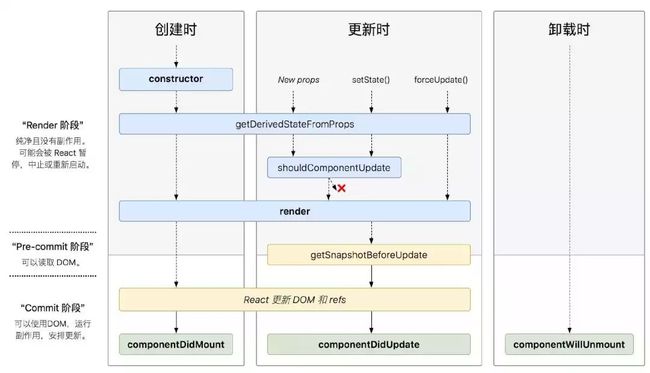生命周期
一般将生命周期分成三个阶段:
创建阶段(Mounting)
更新阶段(Updating)
卸载阶段(Unmounting)
从 React v16 开始,还对生命周期加入了错误处理(Error Handling)。
React 16.3 新增的生命周期方法
getDerivedStateFromProps()
getSnapshotBeforeUpdate()
逐渐废弃的生命周期方法:
componentWillMount()
componentWillReceiveProps()
componentWillUpdate()
虽然废弃了这三个生命周期方法,但是为了向下兼容,将会做渐进式调整。(详情见#12028)
V16.3 并未删除这三个生命周期,同时还为它们新增以 UNSAFE_ 前缀为别名的三个函数 UNSAFE_componentWillMount()、UNSAFE_componentWillReceiveProps()、UNSAFE_componentWillUpdate()。
在 16.4 版本给出警告将会弃用 componentWillMount()、componentWillReceiveProps()、componentWillUpdate()三个函数
然后在 17 版本将会删除 componentWillMount()、componentWillReceiveProps()、componentWillUpdate() 这三个函数,会保留使用 UNSAFE_componentWillMount()、UNSAFE_componentWillReceiveProps()、UNSAFE_componentWillUpdate()
创建阶段 Mounting
组件实例创建并插入 DOM 时,按顺序调用以下方法:
-constructor()
-static getDerivedStateFromProps()
-componentWillMount()/UNSAFE_componentWillMount()(不建议)
-render()
-componentDidMount()
有定义 getDerivedStateFromProps 时,会忽略 componentWillMount()/UNSAFE_componentWillMount()
constructor()
constructor(props)
构造函数通常用于:
- 使用 this.state 来初始化 state
- 给事件处理函数绑定 this
注意:ES6 子类的构造函数必须执行一次super()。React 如果构造函数中要使用this.props,必须先执行super(props)。 static getDerivedStateFromProps()
static getDerivedStateFromProps(nextProps, prevState)
当创建时、接收新的 props 时、setState 时、forceUpdate 时会执行这个方法。
注意:v16.3 setState 时、forceUpdate 时不会执行这个方法,v16.4 修复了这个问题。
这是一个 静态方法,参数 nextProps 是新接收的 props,prevState 是当前的 state。返回值(对象)将用于更新 state,如果不需要更新则需要返回 null。
class ExampleComponent extends React.Component {
// Initialize state in constructor,
// Or with a property initializer.
state = {
isScrollingDown: false,
lastRow: null,
};
static getDerivedStateFromProps(props, state) {
if (props.currentRow !== state.lastRow) {
return {
isScrollingDown: props.currentRow > state.lastRow,
lastRow: props.currentRow,
};
}
// Return null to indicate no change to state.
return null;
}
/* 父组件传入新的 props 时,用来和当前的 state 对比,判断是否需要更新 state。
以前一般使用 componentWillReceiveProps 做这个操作。 */
这个方法在建议尽量少用,只在必要的场景中使用,一般使用场景如下:
- 无条件的根据 props 更新 state
- 当 props 和 state 的不匹配情况更新 state
componentWillMount()/UNSAFE_componentWillMount()(弃用)
UNSAFE_componentWillMount()
这个方法已经不推荐使用。因为在未来异步渲染机制下,该方法可能会多次调用。它所行使的功能也可以由 componentDidMount() 和 constructor()代替:
之前有些人会把异步请求放在这个生命周期,其实大部分情况下都推荐把异步数据请求放在 componentDidMount() 中。
在服务端渲染时,通常使用 componentWillMount() 获取必要的同步数据,但是可以使用 constructor() 代替它。
可以使用 setState,不会触发 re-render
render
render()
每个类组件中,render() 是唯一必须的方法。render() 正如其名,作为渲染用,可以返回下面几种类型:
-React 元素(React elements)
-数组(Arrays)
-片段(fragments)
-插槽(Portals)
-字符串或数字(String and numbers)
-布尔值或 null(Booleans or null)
注意:
Arrays 和 String 是 v16.0.0 新增。
fragments 是 v16.2.0 新增。
Portals 是 V16.0.0 新增。
里面不应该包含副作用,应该作为纯函数。
不能使用 setState。
componentDidMount()
componentDidMount()
组件完成装载(已经插入 DOM 树)时,触发该方法。这个阶段已经获取到真实的 DOM。
一般用于下面的场景:
-异步请求 ajax
-添加事件绑定(注意在 componentWillUnmount 中取消,以免造成内存泄漏)
可以使用 setState,触发re-render,影响性能。
更新阶段 Updating
-componentWillReceiveProps()/UNSAFE_componentWillReceiveProps()(不推荐)
-static getDerivedStateFromProps()
-shouldComponentUpdate()
-componentWillUpdate()/UNSAFE_componentWillUpdate()(不推荐)
-render()
-getSnapshotBeforeUpdate()
-componentDidUpdate()
有 getDerivedStateFromProps 或者 getSnapshotBeforeUpdate 时,componentWillReceiveProps()/UNSAFE_componentWillReceiveProps()和 componentWillUpdate()/UNSAFE_componentWillUpdate()不会执行 (详情查看源码)
-
componentWillReceiveProps()/UNSAFE_componentWillReceiveProps()(弃用)
UNSAFE_componentWillReceiveProps(nextProps)
这个方法在接收新的 props 时触发,即使 props 没有变化也会触发。一般用这个方法来判断 props 的前后变化来更新 state,如下面的例子:
class ExampleComponent extends React.Component {
state = {
isScrollingDown: false,
};
componentWillReceiveProps(nextProps) {
if (this.props.currentRow !== nextProps.currentRow) {
this.setState({
isScrollingDown:
nextProps.currentRow > this.props.currentRow,
});
}
}
}
这个方法将被弃用,推荐使用 getDerivedStateFromProps 代替。
可以使用 setState
-
static getDerivedStateFromProps()
同 Mounting 时所述一致。 -
shouldComponentUpdate()
在接收新的 props 或新的 state 时,在渲染前会触发该方法。
该方法通过返回 true 或者 false 来确定是否需要触发新的渲染。返回 false, 则不会触发后续的UNSAFE_componentWillUpdate()、render()和componentDidUpdate()(但是 state 变化还是可能引起子组件重新渲染)。所以通常通过这个方法对 props 和 state 做比较,从而避免一些不必要的渲染。
PureComponent 的原理就是对 props 和 state 进行浅对比(shallow comparison),来判断是否触发渲染。 -
componentWillUpdate()/UNSAFE_componentWillUpdate()(弃用)
UNSAFE_componentWillUpdate(nextProps, nextState)
当接收到新的 props 或 state 时,在渲染前执行该方法。
在以后异步渲染时,可能会出现某些组件暂缓更新,导致 componentWillUpdate 和 componentDidUpdate 之间的时间变长,这个过程中可能发生一些变化,比如用户行为导致 DOM 发生了新的变化,这时在 componentWillUpdate 获取的信息可能就不可靠了。
不能使用 setState
-
render()
同 Mounting 时所述一致。 getSnapshotBeforeUpdate()
getSnapShotBeforeUpdate(prevProps, prevState)
这个方法在 render() 之后,componentDidUpdate() 之前调用。
两个参数 prevProps 表示更新前的 props,prevState 表示更新前的 state。
返回值称为一个快照(snapshot),如果不需要 snapshot,则必须显示的返回 null —— 因为返回值将作为 componentDidUpdate() 的第三个参数使用。所以这个函数必须要配合 componentDidUpdate() 一起使用。
这个函数的作用是在真实 DOM 更新(componentDidUpdate)前,获取一些需要的信息(类似快照功能),然后作为参数传给 componentDidUpdate。例如:在 getSnapShotBeforeUpdate 中获取滚动位置,然后作为参数传给 componentDidUpdate,就可以直接在渲染真实的 DOM 时就滚动到需要的位置。
class ScrollingList extends React.Component {
constructor(props) {
super(props);
this.listRef = React.createRef();
}
getSnapshotBeforeUpdate(prevProps, prevState) {
// Are we adding new items to the list?
// Capture the scroll position so we can adjust scroll later.
if (prevProps.list.length < this.props.list.length) {
const list = this.listRef.current;
return list.scrollHeight - list.scrollTop;
}
return null;
}
componentDidUpdate(prevProps, prevState, snapshot) {
// If we have a snapshot value, we've just added new items.
// Adjust scroll so these new items don't push the old ones out of view.
// (snapshot here is the value returned from getSnapshotBeforeUpdate)
if (snapshot !== null) {
const list = this.listRef.current;
list.scrollTop = list.scrollHeight - snapshot;
}
}
render() {
return (
{/* ...contents... */}
);
}
componentDidUpdate()
componentDidUpdate(prevProps, prevState, snapshot)
这个方法是在更新完成之后调用,第三个参数 snapshot 就是 getSnapshotBeforeUpdate 的返回值。
正如前面所说,有 getSnapshotBeforeUpdate 时,必须要有 componentDidUpdate。所以这个方法的一个应用场景就是上面看到的例子,配合 getSnapshotBeforeUpdate 使用。
可以使用 setState,会触发 re-render,所以要注意判断,避免导致死循环。
卸载阶段 Unmounting
componentWillUnmount()
componentWillUnmount()
在组件卸载或者销毁前调用。这个方法主要用来做一些清理工作,例如:
-取消定时器
-取消事件绑定
-取消网络请求
不能使用 setState
错误处理 Error Handling
componentDidCatch()
componentDidCatch(err, info)
任何子组件在渲染期间,生命周期方法中或者构造函数 constructor 发生错误时调用。
错误边界不会捕获下面的错误:
-事件处理 (Event handlers) (因为事件处理不发生在 React 渲染时,报错不影响渲染)
-异步代码 (Asynchronous code) (e.g. setTimeout or requestAnimationFrame callbacks)
-服务端渲染 (Server side rendering)
-错误边界本身(而不是子组件)抛出的错误
